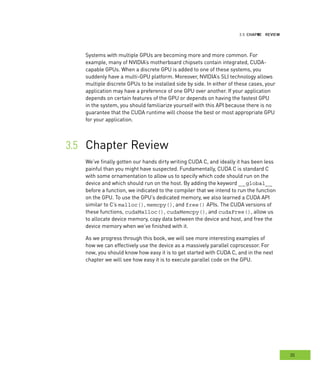Chapter 3 of the document introduces CUDA C programming, emphasizing its ability to harness the power of graphics processors. It explains how to write and run CUDA C code, manage device memory, and interact with CUDA-capable devices. Additionally, the chapter covers the importance of querying device properties, memory allocation, and the limitations of using device pointers in host code.
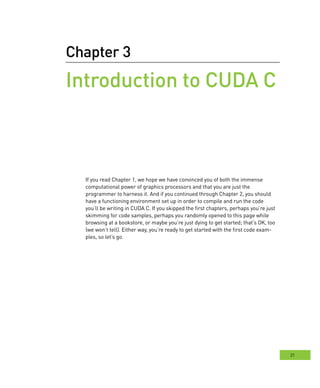

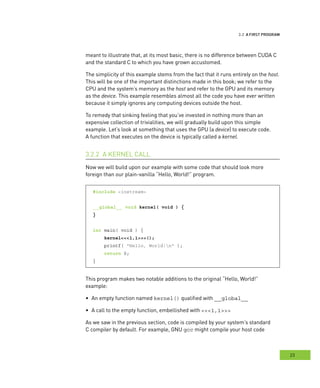


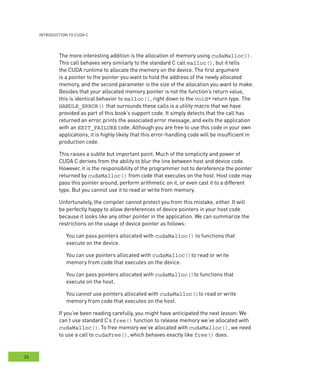
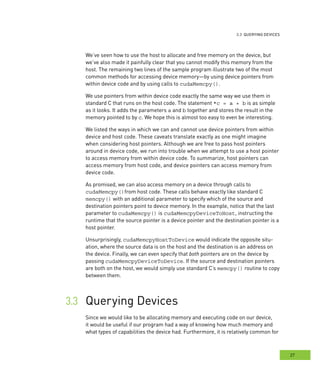
![C
28
people to have more than one CUDA-capable device per computer. In situations
like this, we will definitely want a way to determine which processor is which.
For example, many motherboards ship with integrated NVIDIA graphics proces-
sors. When a manufacturer or user adds a discrete graphics processor to this
computer, it then possesses two CUDA-capable processors. Some NVIDIA prod-
ucts, like the GeForce GTX 295, ship with two GPUs on a single card. Computers
that contain products such as this will also show two CUDA-capable processors.
Before we get too deep into writing device code, we would love to have a
mechanism for determining which devices (if any) are present and what capa-
bilities each device supports. Fortunately, there is a very easy interface to
determine this information. First, we will want to know how many devices in the
system were built on the CUDA Architecture. These devices will be capable of
executing kernels written in CUDA C. To get the count of CUDA devices, we call
cudaGetDeviceCount(). Needless to say, we anticipate receiving an award
for Most Creative Function Name.
int count;
HANDLE_ERROR( cudaGetDeviceCount( &count ) );
After calling cudaGetDeviceCount(), we can then iterate through the devices
and query relevant information about each. The CUDA runtime returns us these
properties in a structure of type cudaDeviceProp. What kind of properties
can we retrieve? As of CUDA 3.0, the cudaDeviceProp structure contains the
following:
struct cudaDeviceProp {
char name[256];
size_t totalGlobalMem;
size_t sharedMemPerBlock;
int regsPerBlock;
int warpSize;
size_t memPitch;
int maxThreadsPerBlock;
int maxThreadsDim[3];
int maxGridSize[3];
size_t totalConstMem;
int major;](https://image.slidesharecdn.com/cudabyexample-pages-42-56-200908163411/85/CUDA-by-Example-Introduction-to-CUDA-C-Notes-8-320.jpg)
![QueryInG devIces
29
evices
int minor;
int clockRate;
size_t textureAlignment;
int deviceOverlap;
int multiProcessorCount;
int kernelExecTimeoutEnabled;
int integrated;
int canMapHostMemory;
int computeMode;
int maxTexture1D;
int maxTexture2D[2];
int maxTexture3D[3];
int maxTexture2DArray[3];
int concurrentKernels;
}
Some of these are self-explanatory; others bear some additional description (see
Table 3.1).
Table 3.1 CUDA Device Properties
DEvICE ProPErty n
char name[256]; An ASCII string identifying the device (e.g.,
"GeForce GTX 280")
size_t totalGlobalMem The amount of global memory on the device in
bytes
size_t sharedMemPerBlock The maximum amount of shared memory a single
block may use in bytes
int regsPerBlock The number of 32-bit registers available per block
int warpSize The number of threads in a warp
size_t memPitch The maximum pitch allowed for memory copies in
bytes
Continued](https://image.slidesharecdn.com/cudabyexample-pages-42-56-200908163411/85/CUDA-by-Example-Introduction-to-CUDA-C-Notes-9-320.jpg)
![C
30
DEvICE ProPErty DESCrIPtIoN
int maxThreadsPerBlock The maximum number of threads that a block may
contain
int maxThreadsDim[3] The maximum number of threads allowed along
each dimension of a block
int maxGridSize[3] The number of blocks allowed along each
dimension of a grid
size_t totalConstMem The amount of available constant memory
int major The major revision of the device’s compute
capability
int minor The minor revision of the device’s compute
capability
size_t textureAlignment The device’s requirement for texture alignment
int deviceOverlap A boolean value representing whether the device
can simultaneously perform a cudaMemcpy()
and kernel execution
int multiProcessorCount The number of multiprocessors on the device
int kernelExecTimeoutEnabled A boolean value representing whether there is a
runtime limit for kernels executed on this device
int integrated A boolean value representing whether the device is
an integrated GPU (i.e., part of the chipset and not a
discrete GPU)
int canMapHostMemory A boolean value representing whether the device
can map host memory into the CUDA device
address space
int computeMode A value representing the device’s computing mode:
default, exclusive, or prohibited
int maxTexture1D The maximum size supported for 1D textures
Table 3.1 Caption needed (Continued)](https://image.slidesharecdn.com/cudabyexample-pages-42-56-200908163411/85/CUDA-by-Example-Introduction-to-CUDA-C-Notes-10-320.jpg)
![QueryInG devIces
31
evices
DEvICE ProPErty DESCrIPtIoN
int maxTexture2D[2] The maximum dimensions supported for 2D
textures
int maxTexture3D[3] The maximum dimensions supported for 3D
textures
int maxTexture2DArray[3] The maximum dimensions supported for 2D
texture arrays
int concurrentKernels A boolean value representing whether the device
supports executing multiple kernels within the
same context simultaneously
We’d like to avoid going too far, too fast down our rabbit hole, so we will not
go into extensive detail about these properties now. In fact, the previous list is
missing some important details about some of these properties, so you will want
to consult the NVIDIA CUDA Programming Guide for more information. When you
move on to write your own applications, these properties will prove extremely
useful. However, for now we will simply show how to query each device and report
the properties of each. So far, our device query looks something like this:
#include "../common/book.h"
int main( void ) {
cudaDeviceProp prop;
int count;
HANDLE_ERROR( cudaGetDeviceCount( &count ) );
for (int i=0; i< count; i++) {
HANDLE_ERROR( cudaGetDeviceProperties( &prop, i ) );
//Do something with our device's properties
}
}
Table 3.1 CUDA Device Properties (Continued)](https://image.slidesharecdn.com/cudabyexample-pages-42-56-200908163411/85/CUDA-by-Example-Introduction-to-CUDA-C-Notes-11-320.jpg)
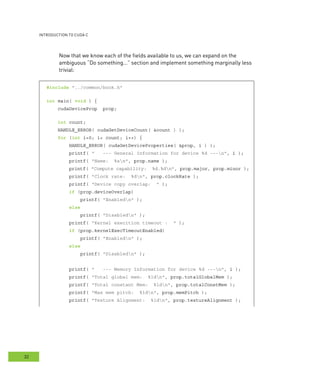
![usInG devIce ProPertIes
33
roperties
printf( " --- MP Information for device %d ---n", i );
printf( "Multiprocessor count: %dn",
prop.multiProcessorCount );
printf( "Shared mem per mp: %ldn", prop.sharedMemPerBlock );
printf( "Registers per mp: %dn", prop.regsPerBlock );
printf( "Threads in warp: %dn", prop.warpSize );
printf( "Max threads per block: %dn",
prop.maxThreadsPerBlock );
printf( "Max thread dimensions: (%d, %d, %d)n",
prop.maxThreadsDim[0], prop.maxThreadsDim[1],
prop.maxThreadsDim[2] );
printf( "Max grid dimensions: (%d, %d, %d)n",
prop.maxGridSize[0], prop.maxGridSize[1],
prop.maxGridSize[2] );
printf( "n" );
}
}
Using Device Properties
Other than writing an application that handily prints every detail of every CUDA-
capable card, why might we be interested in the properties of each device in our
system? Since we as software developers want everyone to think our software is
fast, we might be interested in choosing the GPU with the most multiprocessors
on which to run our code. Or if the kernel needs close interaction with the CPU,
we might be interested in running our code on the integrated GPU that shares
system memory with the CPU. These are both properties we can query with
cudaGetDeviceProperties().
Suppose that we are writing an application that depends on having double-
precision floating-point support. After a quick consultation with Appendix A of the
NVIDIA CUDA Programming Guide, we know that cards that have compute capa-
bility 1.3 or higher support double-precision floating-point math. So to success-
fully run the double-precision application that we’ve written, we need to find at
least one device of compute capability 1.3 or higher.](https://image.slidesharecdn.com/cudabyexample-pages-42-56-200908163411/85/CUDA-by-Example-Introduction-to-CUDA-C-Notes-13-320.jpg)

